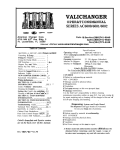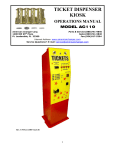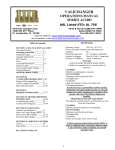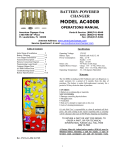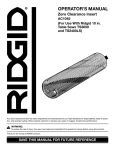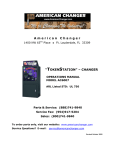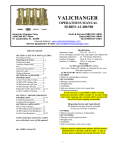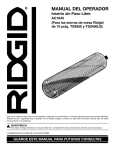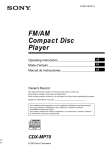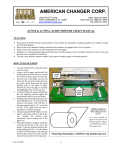Download UNCRATING AND SET-UP
Transcript
VALICHANGER OPERATIONS MANUAL SERIES AC250 American Changer Corp. 1400 NW 65TH Place Ft. Lauderdale, FL 33309 Parts & Service:(888)741-9840 Sales:(800)741-9840 Fax:(954)917-5204 Internet Address: www.americanchanger.com Service Questions?: e-mail [email protected] Table of Contents Specifications SECT. A: SET-UP & INSTALLATION Uncrating & Setup 3 3 Using the Keypad 3 Keypad Disable Keys 3 Keypad Resettable Counter 3 Hopper Coin/Token Sizes 3 Filling the Hopper 4 Hopper Dump Feature 4 Fuse 4 Software Settings 5 Functional Description 5-6 Out-of-Service Conditions 6 Indicator Lights 6 Wiring definitions SECTION B: COIN HOPPER INFORMATION 7-13 SECTION D: TROUBLESHOOTING 14-15 INFORMATION SECTION E: PARTS LISTS Cabinet Parts List Coin Hopper Parts List 16 17 Operating Voltage Power Consumption Operating Temperature Interface to Hopper 120 VAC +10/-15 % Controller: 10W, Hopper: 48W Max 32 - 130 degrees Fahrenheit 24Vdc, ccTalk Serial Protocol Warranty Dispensing System, Keypad and Logic Board The coin dispenser, keypad, and logic board are under warranty for one year from date of purchase. COVERED ¥ Defects caused by workmanship or materials NOT COVERED ¥ Damage caused by physical abuse ¥ Misapplication ¥ Vandalism ¥ End User’s attempt to repair on his own A Return Material Authorization number (RMA#) must be obtained before returning a unit for repair. A copy of invoices must accompany any and all warranty work. Rev. UNV_F06 Apr’05 1 Attention Please: To ensure the most trouble-free machine operation, we recommend plugging all our machines into a DEDICATED AC outlet. (This means there are no other machines on location plugged into the same AC line.) A simple way to check if this is true is to turn off the breaker at the fuse box associated with our machine. No other machines on location should lose power or turn off. American Changer is now building in a Surge Suppressor on every main logic board made after September 1st, 1998. This will help eliminate power related noise problems for our customers. It will not protect you from large voltage spikes or lightning strikes over 150VAC. If this is a concern for your area of business, we recommend purchasing a surge protector locally NOTE: A POWER STRIP IS NOT A SURGE PROTECTOR. AC ____________ S/N# __________________ Tested By ___________________________ Date __________________ Thank You, American Changer Corp. (888) 741-9840 2 UNCRATING AND SET-UP HOPPER COIN/TOKEN SIZES Remove your AC250 changer from the shipping box. Open the door. (The T-handle is a screw-in type and therefore, must be turned at least 10 times counter-clockwise until it opens.) Inspect for any connectors or components that may have been dislodged during shipping. The lock and keys for your changer will be inside the manila envelope along with this manual. To install the lock, insert the cylinder into the round hole in the middle of the T-handle and push until it stops. Now turn the key and lock until you hear it “snap." Turn the key counter-clockwise ¼ turn and remove the keys. The hopper will automatically adjust to dispense coins/tokens in size from 20-30 mm in diameter and 1.25 - 3.5 mm in thickness. There is an option available to dispense smaller coins. A nickel is approximately 21 mm, a quarter is approximately 25mm, and a Susan B. Anthony is approximately 28mm in diameter. FILLING THE HOPPER When the hopper has less than 80 - 100 coins left in it the red “Out-of-Service” LED will light on the front of the changer. Open the door and check that a “Hopper Low” error message is being displayed on the Main Logic Board’s LCD screen. 1. Turn OFF the power on the main logic board. 2. Slide the hopper out from the cabinet and insert the coins through the opening on the top. There must be at least enough coins to cover the two gold plates at the bottom of the hopper. (Somewhere between 160 and 1600 coins minimum to maximum.) 3. Slide the hopper back into the hopper plate. Do not use excessive force! 4. Turn “ON” the power switch. The “Out-of-Service” LED is now off and the changer is ready to dispense coins. TEST: Before permanently installing the changer, do a functional test to verify that there is no shipping damage to your new changer(s). NOTE: The only way to get a duplicate set of keys made is to save the red tag that comes between the keys. This ID # starts with ACC ####. Write your Key # Here ACC_____________. ALL KEY ORDERS TAKE 4-6 WEEKS!!! Extend the power cord through the hole in the back of the changer or the bottom and plug it into a grounded 120vac outlet. The Logic Board is already set to dispense the number of coins entered into the keypad out of the hopper. Fill the hopper with at least 100 coins. On the main logic board turn the switch on the bottom right corner “ON”. The rocker switch has an “I” and an “O” printed on it. When the “I” is pressed down, the changer is “ON”. Hopper coin bin. (Dump the coins into this hole. 1600 coins max.) USING THE KEYPAD: Type in the number of coins/tokens you wish to dispense from the machine using the numbers on the keypad (this can be any amount between 1 and 99). The numbers you type will appear on the display. If a mistake is made, press the “CLEAR” key to clear the display so the correct amount can be entered. When the desired amount is displayed, press the “PAY” key to begin dispensing. THE KEYPAD DISABLE KEYS The second set of keys included in the manila envelope is for the Keypad ON/OFF switch lock in the back of the AC250. These keys will disable the AC250’s Keypad if you ever have to leave the counter unattended. Before leaving the machine, turn the key switch and remove the keys. Now the keypad is disabled; the machine will not pay out by using the keypad. Motor KEYPAD RESETTABLE COUNTER The remote keypad has a hidden resettable counter feature kept on the keypad itself. To access this counter, hold the keypad and press the #7, #4, and #1 keys SIMULTANEOUSLY. The number that appears is the count of total coins dispensed. To clear the meter, press the #9, #6, and #3 keys SIMULTANEOUSLY while the count is being displayed. The meter count will be reset to zero. Press the Clear key at any point to return to regular operation. NOTE: THIS COUNTER IS NOT THE METER COUNTER THAT IS NON-RESETTABLE LOCATED ON THE LOGIC BOARD INSIDE THE MACHINE! Please open the door to access that counter. 12-pin female connector (Located on the opposite side.) Money Controls MKIV Coin Hopper 3 3. USING THE DUMP MODE TO EMPTY THE HOPPER 1. 2. 3. 4. 5. Open the changer door to give access to the Main Logic Board and the hopper. Place a suitable container in front of the hopper to catch the dispensed coins as they are being ejected. On the Main Logic Board, press and hold buttons #1 and #2 (Up and Down) simultaneously, until the hopper begins to “Dump” the coins. If after a few seconds the hopper has not begun to eject coins, the “Dump” feature is disabled in the software, and needs to be enabled. If the dumping works, skip to step #4. a. To enable the “Dump” feature, enter the board’s Program Mode by pressing Select (button #3). b. Scroll down using button #2 until the Hardware (“Hardwr”) menu is highlighted, and then press Select. Inside the Hardware menu, scroll down and enter the “Dump” menu by pressing Select again. c. This will bring up a screen that says “Dump” and “N”. Push the down button twice to scroll past “Exit” and display a “Y” for Yes. Once the “Y” is highlighted press the Select button to save and exit the Program Mode. Dumping is now enabled; press and hold buttons #1 and #2 simultaneously, again, until the hopper begins dispensing coins. Once the hopper is emptying, it will continue to run until manually stopped by pressing the Select (SEL) button on the MLB. Dumping may be stopped at any time, or allowed to continue until the hopper is totally empty. During the dump, a count of the number of coins being dispensed is displayed on the LCD screen. If the hopper is completely emptied, this count will show how many coins were initially in the hopper before dumping began. Press the SELECT button to enter the software Setup Mode, where a menu starting with “Bills” should be displayed. Using the DOWN button, scroll down until the Hardware (“Hardwr”) submenu is highlighted, and then press SELECT; this will enter the Hardware submenu. 4. 5. 6. FUSE 7. High voltage fuse: This is the primary AC transformer fuse for the main logic board, hopper, and keypad. Any direct short of the Transformer or any of the peripheral devices will cause this fuse to blow. Replace this fuse with a 2-½ amp AS fuse only. REPLACING THIS FUSE WITH ANYTHING OTHER THAN A 2 ½ AMP “AS” MAY RESULT IN A FIRE OR AN UNSAFE WORKING CONDITION!! 8. SOFTWARE SETTINGS CAUTION: The software settings on the Main Logic Board are programmed at the factory, and should not be altered under normal circumstances. ONLY if they become accidentally changed or the unit stops working should an attempt be made to return the software to its original settings. The following procedure explains how to reprogram the Logic Board for proper operation of the changer. These instructions should be followed step by step as they are written; please contact American Changer’s Parts & Service department at (888) 741-9840 if assistance is needed. 1. Turn ON the power to the Main Logic Board, and wait approximately 30 seconds for its initialization procedures to finish. 2. The UP and DOWN buttons on the MLB are used to scroll through the menu choices and to increase or decrease values, and the SELECT button is used to make selections and to save values (refer to Figure 1 for button locations). 4 Immediately press the SELECT button again, while “Hoppers” is highlighted, to enter the Hoppers submenu. Inside this submenu press SELECT on “ccTalk”, scrolling down if necessary. The ccTalk submenu contains three choices: 1, 2, or Exit. Maneuver the cursor, if necessary, using the DOWN button and SELECT “1”. Your choice will be saved, and the display will return automatically to the Standby screen. You have just told the control board that the unit contains one ccTalk coin hopper. Re-enter the Hardware submenu as explained in step #3. Once inside, scroll DOWN and SELECT “CoinAcc” to enter the Coin Acceptor submenu. Here, scroll DOWN until the cursor points to “None!”, and then press SELECT. This tells the board that there is no coin acceptor installed in the machine. The next step is to program the control board to receive payout instructions from the Keypad, as it would a validator in another changer. Re-enter the Hardware submenu, as explained in step #3, and scroll DOWN until “Valid.” is highlighted. Press SELECT to enter the Validator submenu. Once inside, choose “MDB” by scrolling, if necessary, and pushing SELECT. Then, move the cursor DOWN until it points to “None!”, and push SELECT again. Now, repeat this step (#6) up to the point directly after you enter the Validator submenu. This time, scroll DOWN and SELECT the “Pulse” option. In the “Pulse” submenu, SELECT “1”, and in the submenu that immediately follows (Enable), SELECT “Hi”. Once again, re-enter the Hardware submenu as detailed in step #3. Move the cursor DOWN and SELECT “Mode”. Inside of the Mode submenu, scroll DOWN until the option “S Chngr” is highlighted, and press SELECT. This is the hardware mode the AC250 must be set to for it to function properly. The last step in this procedure is to configure the control board to pay out the exact number of tokens signaled by the Keypad. To do this, enter the software Setup Mode by pressing SELECT while on the Standby screen. Move the cursor down one space so that it points to “PayOut”, and press SELECT. The Payout submenu should contain one heading titled “Change” (if not, the hardware mode is set improperly; repeat from step #7). Use the UP and DOWN buttons to increase or decrease, respectively, the “Change” value until it reads exactly $1.00, and then press SELECT. Programming is complete; turn the power OFF and then ON again before using your changer. LCD Display Coin Hopper Red LED Indicator NOT CONNECTED Keypad “Out of Service” LED NOT CONNECTED NOT CONNECTED Button #1 (UP) Button #3 (SELECT) Button #2 (DOWN) Figure 1 – Main Logic Board (MLB) 6. FUNCTIONAL DESCRIPTION OF THE AC250 SERIES CHANGER To follow along with this walk-through of your changer, fill the hopper with coins and turn the changer ON. 1. 2. 3. 4. 5. When power is applied the out-of-service LED flashes ON then goes out. The LCD screen on the Main Logic Board (MLB) will display the Software version installed in the board’s EEPROM, and its backlight will be ON continuously. The small red status LED above the display will begin to blink once per second in the Standby mode, while the board is waiting for a keypad entry. During the Power-up sequence, the Main Logic Board will read the user-programmed settings stored in its memory. The current count of total coins (tokens) dispensed is displayed on the LCD screen at this time. Using ccTalk communication protocol, the MLB initializes the hopper by communicating the current program settings to it, enabling it, and checking it for any error conditions. The MLB thereafter periodically polls the hopper to check if it has any errors. The keypad uses Pulse communication to tell the Main Logic Board how many coins to dispense. When the “Enter” button is pressed, the keypad’s circuitry grounds the 5VDC “bill in” line for a short time, creating a pulse. The number of pulses it produces in a row corresponds to the number shown on the keypad display, e.g. the line is pulsed 5 times if “5” is entered into the keypad. The Logic Board counts the 5VDC pulses, assigning each one a value of one dollar. It then divides the total amount by the “payout” setting to get the actual number of coins to dispense (refer to the “Software Settings” section on pgs. 3-4). Note: “Payout” must be set to exactly $1.00 to dispense the number of coins that is entered into the keypad, otherwise the count will be different. The MLB then communicates to the hopper how many coins to dispense. A “Busy” message appears on the LCD display while the board is making calculations and transmitting data. 7. The hopper turns itself ON when it receives the count data from the MLB; this starts the coins dispensing. As the coins exit the hopper they pass an Optical Sensor, which keeps track of how many are being dispensed. When the count from the hopper’s Optical Sensor equals the number sent by the Main Logic Board, the hopper turns itself OFF. The Changer returns to the standby mode with the red LED flashing once per second until another entry is made on the keypad. NOTE: THE METER ON THE MAIN LOGIC BOARD LCD DISPLAY CANNOT BE RESET TO ZERO!!! OUT-OF-SERVICE CONDITIONS Out-of-Service conditions can occur in the AC250 due to either a blown fuse or a hopper fault. Blown Fuse: An AC power spike in line voltage or a bad transformer on the Power Supply board can cause a blown fuse. If the primary fuse blows, the indication is that the green LED on the power supply will not light. 1. Replace the fuse. If the green LED now lights then there was a spike. 2. If it does not light and the fuse blows again, disconnect the hopper and keypad connectors and try again. If the green LED stays lit, reconnect each component one at a time until you find the one blowing the fuse. 2. If the fuse still blows with all components removed from the MLB, the power transformer is shorted. To test the transformer, use a multimeter set for ohms and measure across the primary (40ohms) and the secondary (1.5ohms). 5 INDICATOR LIGHTS Hopper Faults: Hopper faults occur for a variety of reasons, but the most common in any coin machine is always low coins. Any of the hopper faults will cause the Out-of Service light on the front of the machine to illuminate. For the following, if two hoppers are installed in the machine, X = L (left) or R (right). 1. Hopper.NoComm – The changer’s Main Logic Board is unable to communicate with the hopper. This may be a temporary condition, or the cable harness may be loose or unplugged, or the hopper may need to be repaired or replaced. Note: If using only one hopper, it must be plugged into the left-side connector (see Fig. 1). 2. Hopper.NoPay – This code signifies that a payout signal was sent to the hopper, but the hopper did not dispense any coins/tokens. Check the hopper for a possible coin jam, exit blockage, or other mechanical fault. If nothing can be found, have the unit repaired or replaced. Note: If using two hoppers and one of them fails to pay out, the other hopper will make up the difference, if it can. 3. Hopper.OptoBlkd – An optical sensor near the exit window is being blocked. The exit path may be obstructed, or the Optic Board may be bad. Repair or replace. 4. Hopper.Current – The maximum current level for the hopper is being exceeded. Inspect for a jammed coin preventing the coin Elevator Track from moving, or a stalled or shorted motor. Repair or replace the hopper. 5. Hopper.Fraud – The changer may be being defrauded. Inspect and repair or replace the hopper. 6. Hopper.TimeOut – The coins/tokens were not dispensed from the hopper in the specified time. Check the hopper for any coin jams or mechanical obstructions preventing coins from exiting. Have the unit repaired or replaced. 7. Hopper.Low – This is the most common error; it signals Low Coins in the hopper. Refill the hopper with coins or tokens. If you have enough coins in the hopper to cover the gold low-level sensing plates and you are still getting this message, try the following: A. Ensure the coins have not bridged in the extension on top of the hopper preventing them from falling down into the hopper. B. Clean the bottom gold plates of the hopper with EMERY cloth or fine sandpaper. Refill the hopper and try again. C. Using an ohmmeter, check the continuity of the hopper harness from the 12-pin connector back to the logic board. You should get 0 ohms for each line. If none of this works, the unit may need repair or replacement. Main Logic Board: 1. Red LED a. Heartbeat – 24, 5, and 3.3VDC present; the changer is operating normally. 2. LCD Display Backlight a. ON Steady – Normal operation; this applies to both Standby and Programming modes. b. Blinking – Error condition present; the backlight blinks synchronously with the Red LED (see pgs. 5-6 for error message descriptions). WIRE HARNESS COLOR AND DEFINITIONS Keypad harness: Blue - Ground White - Bill In line (pre-disable lock) Red - Bill In line (post-disable lock) Orange - +24 VDC supply Hopper Harness: Black(s) - Ground Orange - +24 VDC supply Green - Data line (Tx & Rx) Yellow - No Connection 6 MKIV UNIVERSAL HOPPER INDEX 1. Coin box removal & assembly PAGE 8-9 2. Exit window replacement 9 3. Logic board replacement 10 4. End plate removal 10 5. Track plate removal 10 5a. Track plate Assembly 11 5b. Track plate Replacement 12 5c. Final drive gear replacement 12 6. Gearbox assembly 13 7. 7. Motor replacement 13 To UN-jam the hopper, refer to sections 4 – 5b, pages 10–12. SERVICE MANUAL 7 6. 1. COIN BOX REMOVAL 1. Place the hopper in front of you as shown, (looking at the outside of the ‘coin box’). As the ‘coin box’ is being removed, carefully slide the ‘logic board’ out. The stirrer may stay with the ‘coin box’ or fall onto the center plate. Refer to FIG 1. 2. Remove the 2 locking nuts, which hold the ‘low level sense plate’ wires to the studs. 3. Remove the crimp & wire from the studs. ACCESS IS NOW AVAILABLE TO THE ‘LOW LEVEL’ SENSE PLATES, THE MAIN PCB, THE EXIT WINDOW, THE MOTOR TERMINALS & PART OF THE WIRING LOOM. Refer to FIG 1a. 4. Remove the 5 screws indicated (B), which hold the ‘coin box’ to the ‘center plate’. 5. Gently lift the ‘coin box’ away from the rest of the hopper. (Refer to FIG 1b) 1a. COIN BOX ASSEMBLY 1. NOTE: The ‘logic board’ & ‘stirrer’ are located in the ‘coin box’. 8 Firstly, locate the ‘stirrer in the ‘coin box as shown in FIG 12. COIN BOX ASSEMBLY (cont.) 2. Line up the ‘center plate’ & ‘coin box’ as shown below. FIG 12a. 3. Route the ribbon cable as shown below. 4. Fit the ‘logic board’ into slots shown below. 5. Feed the level sense wires through the slot shown below. 7. 8. 9. Align the ‘center plate’ & ‘coin box’ & push together. Turn the hopper over & refit the screws. Refit the level sense wires. 2. EXIT WINDOW REPLACEMENT 1. First, remove the ‘coin box’, section 1. This will then enable access to the ‘exit window’ 2. Unscrew & remove the 2 fixing screws. (See FIG 4) 3. Remove the ‘exit window’ from the ‘center plate’. 4. Unclip & remove the 10-way ribbon cable header. 6. Lift the ‘centre plate’ to meet the ‘coin box’. FIG 12b & c. 5. 9 To re-assemble, follow the above steps in reverse. 3. LOGIC BOARD REPLACEMENT 1. 4. Holding the ‘connector blanking plate’ gently lift the ‘end plate’ away from the rest of the hopper. 5. To re-assemble, follow the above steps in reverse. First, remove the ‘coin box’, section 1. This will then enable access to the ‘logic board’. 5. TRACK PLATE REMOVAL 1. 2. 3. 4. 5. 6. 7. 8. See FIG 7. 10-way ribbon IDC socket (CONN 1): Move the two ejector arms at right angles to & away from the connector, if fitted. This should release the socket from the header. Clasping the connector between thumb & forefinger, pull away from pin header. 2. 14-way crimp socket (CONN 2): Gently unclip the “friction lock” from the connector housing. Clasping the connector between thumb & forefinger, pull away from pin header. The Logic Board is now released. To re-assemble, follow the above steps in reverse. 4. END PLATE REMOVAL 1. Place the hopper in front of you as shown, (looking at the outside of the ‘end plate’). Refer to FIG 6. 2. Remove the 9 screws indicated (B), which hold the ‘end plate’ to the ‘center plate’. 3. Locate the position of the ‘connector blanking piece’. First, remove the ‘end plate’, section 4. 10 The ‘elevator track’ & ‘final drive gear’ can now be removed by lifting up & away from the ‘center plate’. 5a. TRACK PLATE ASSEMBLY The following 3 sketches show how to take the ‘track plate’ apart. The following 3 sketches show how to assemble the ‘track plate’. 11 5b. TRACK PLATE REPLACEMENT 1. The gray shaded area, in FIG 7b, is the ‘track plate’ guide path. FIG 7b. 2. Once the ‘track plate’ is in position, turn the track through 720 0 to ensure it is seated in the guide path correctly. 5c. FINAL DRIVE GEAR REPLACEMENT 1. 2. Once the ‘elevator track’ is in place, the ‘final drive gear’ can be fitted by placing the gear over its mounting spindle, while lining the teeth up with the secondary drive gear, adjust the ‘elevator track’ so that the gear falls into place. (See FIG 7c) The end plate can now be re-fitted. See section 4. 12 4. 6. GEAR BOX ASSEMBLY 1. Remove the end plate. Section 4. 2. Remove the ‘elevator track’ & ‘final drive gear’. Section 5. 3. Remove the gearbox cover. Access to the motor fixing screws is now possible. 7. MOTOR REPLACEMENT 1. Remove the ‘coin box’. Section 1. 2. Unsolder the red & black wires from the motor. NOTE: The black wire connects to the terminal marked with a RED dot. 3. Remove the ‘end plate’. Section 4. 4. Remove the ‘track plate’ & final drive gear. Section 5 5. Remove the gearbox cover. 6. Disassemble the gearbox. Section 6. Remove the gears in the order as shown in FIG 9. 13 5. To re-assemble, follow the above steps in reverse. 7. Unscrew the 2 motor fixing screws. FIG 10. 8. To re-assemble, follow the above steps in reverse. TROUBLESHOOTING GUIDE TO USE THE TROUBLESHOOTING GUIDE, MATCH UP THE PROBLEM, THEN FOLLOW THE SOLUTION SUGGESTIONS. After every step try operating the changer to see if the problem has been solved. Solution: Problem: 1. 2. 3. A. The changer is completely dead. (The green LED on the Power Supply Board is not lit.) 4. 5. 6. 7. 8. 1. B. The “Out-of-Service” LED is lit. The Main Logic Board is displaying a “Hopper.Low” error message. 2. 3. 4. 5. 6. C. The “Out-of-Service” LED is lit. The MLB is displaying any other error message. D. The green LED on the Power Supply Board is lit, but there is no red “heartbeat” LED on the Main Logic Board. E. The Keypad displays the requested token payout but the meter never counts up. F. The Keypad displays the requested token payout, the meter counts up, but the hopper does not pay out. Ensure the changer is plugged in. Ensure the on/off switch is rocked to the ON (I) position (up). Unplug the female end of the line cord from the main logic board AC connector and plug it in again tightly. Measure the AC voltage at the outlet or check the breaker/fuse box. You can also plug another item into the AC wall outlet to ensure there is power present at the outlet. Inspect the AC line cord for cuts or abrasions. Check the fuse on the Power Supply Board. Replace the line cord. Repair or replace the Power Supply Board. Ensure the hopper is not out of coins. (There should be enough coins in the hopper to cover the gold low-level contact plates. These plates are located at the bottom of the hopper where you pour the coins.) Check the hopper wire harness that extends from the back of the hopper plate for chipped pieces or other damage. Check the continuity of the hopper harness from the 12-pin connector back to the Main Logic Board. You should get 0 Ohms. Clean the gold contact plates with steel wool or fine sandpaper. Replace the hopper wire harness. Repair or replace the hopper. 1. Refer to the “Out-of-Service Conditions” section on pgs. 5-6 for a listing of all software error codes and common solutions. 1. 2. 3. 4. Bad 5VDC or 3.3VDC regulator on the main logic board. The hopper is shorted. Repair or replace the main logic board. Repair or replace the hopper. 1. Ensure that the Keypad Lock on the back of the changer is keyed all the way to the ON position (1/4 key turn clockwise). Check the continuity and look for pin damage to the white and red wires in the keypad wire harness. Replace the keypad wire harness. Repair or replace the keypad. 2. 3. 4. 1. 2. 3. 4. Ensure the software settings are still correct (refer to the “Software Settings” section on pgs. 3-4) Check the continuity of the wires in the hopper wire harness. The hopper is jammed. Go to pgs. 10-12 to unjam the hopper. Replace the hopper wire harness. 14 TROUBLESHOOTING GUIDE TO USE THE TROUBLESHOOTING GUIDE, MATCH UP THE PROBLEM, THEN FOLLOW THE SOLUTION SUGGESTIONS. After every step try operating the changer to see if the problem has been solved. SOLUTION: PROBLEM: 1. G. The Main Logic Board Display is showing a “Hopper.NoComm” Error Message. 2. 3. 4. FOR TECHNICAL SERVICE OR TO OBTAIN A RETURN AUTHORIZATION NUMBER CALL (888)741-9840 Check to see that the hopper is pushed all the way into the changer, so that its 12-pin connector makes full contact with the connector on the back of the hopper plate. The hopper harness may be loose or unplugged; check the continuity of the harness, and repair or replace if necessary. The hopper may be plugged into the wrong connector. It should be plugged in to the Left-side ccTalk connector on the MLB. The hopper is faulty; repair or replace it. ANY REPAIR RETURNED WITHOUT A RETURN MATERIAL AUTHORIZATION NUMBER (RMA#) WILL BE REFUSED!! 15 #5 #6 #7 #3 #2 #4 #10 #1 #8 AC250 CABINET PARTS LIST #1 AC9020.2 #2 AC1065 AC1066 #3 AC1041 #4 AC1040.8H #5 AC5080 #6 AC2210 #7 AC1088 #8 AC1013 #9 AC2210.1 #10 AC2060-20 AC1093.1 AC1093 2050 - KEYPAD W/HARNESS - MAIN LOGIC BOARD W/ LCD DISPLAY - AC-01 POWER MODULE BOARD - MONEY CONTROLS MKIV COIN HOPPER, FRONT LOAD - MONEY CONTROLS HOPPER PLATE WITH HARNESS - SCREW-IN T-HANDLE - CABINET COMPLETE, AC250 - FULL FACE LEXAN FRONT FOR AC250 - COIN CUP FOR AC250 - DOOR FOR AC250 - “OUT-OF-SERVICE” LED LAMP - KEYPAD SWITCH LOCK (NOT SHOWN) - LOCK & KEYS (NOT SHOWN) - MANUAL FOR AC250 (NOT SHOWN) 16 #9 #1 - 1041-24-01 Motor #2 - 1041-24-02 Motor Side Cover #3 - 1041-24-03 Center Plate #4 - 1041-24-04 End Plate #5A- 1041-24-05 Coin Counting Optic Board #5B- 1041-24-06 Optic board ribbon cable #6 - 1041-24-07 Red track plates (16 per belt) #7 - 1041-24-08 Logic board wire harness #8 - 1040-24-113 Male 12 pin connector #9 - 1040-24-112 Female 12 pin connector #10 - 1041-24-10 Idler gear #11 - 1041-24-11 Gear Box #12 - 1041-24-12 Gear Shaft #13 - 1041-24-13 Black plastic Gear #1 #14 - 1041-24-14 Gear #3 & 4 #15 - 1041-24-15 Output gear #16 - 1041-24-16 Idler Gear #4 #17 - 1040-24-22 Blanking Plate #18 - 1040-24-25 Fixing screw. #19 - 1041-24-19 Cam Shaft. #18 #4 #8 #15 #16 #12 #10 17 1041-24-20 Cam shaft bearing. #20 -1041-24-21 Cam Agitator. #17 #11 #6 #13 #14 #3 #7 #23 #5B #21 #21 - 1041-24-22 Agitator. #22 - 1040-24-291 Low level contact plate. #1 #20 #19 #5A #23 - 1041-27-373 Mark IV PC logic board. #22 #18 #2 AC_____________ S/N#_________________ Tested By: Date:________________ 18





















